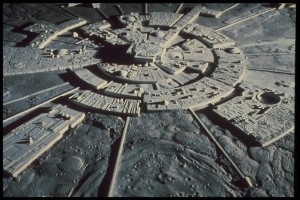 The dream of a new Earth has long been a staple of science fiction. Early practitioners of the art imagined moving from our home planet and on to others where we could stake a claim and create a homestead on a new and pristine world.
The dream of a new Earth has long been a staple of science fiction. Early practitioners of the art imagined moving from our home planet and on to others where we could stake a claim and create a homestead on a new and pristine world.
 Imagining how such an endeavour would be accomplished has been a challenge to scientists and engineers but also to artists. How does one depict these imaginary habitats of the future generations of mankind and keep them scientifically plausible but still imbue them with that essential sense of wonder?
Imagining how such an endeavour would be accomplished has been a challenge to scientists and engineers but also to artists. How does one depict these imaginary habitats of the future generations of mankind and keep them scientifically plausible but still imbue them with that essential sense of wonder?
Leaving alone the concept of extra-solar planets, which in the minds of science fiction writers are discovered to be habitable (sometimes just barely) by plucky humans who are up to the challenge, let’s focus on our local neighborhood. How does a civilization make a home on any of the inhospitable planets of our Solar System? Little or no atmosphere, atmosphere’s that are toxic, atmospheres that have extreme heat or cold, the other planets of our solar system present unique challenges to the potential homesteader.
 The Earth’s Moon is a natural starting point but, again, it is one that presents a number of hurdles that need to be overcome. Scientists, engineers and artists have imagined ways that humasn could make a decent life on the moon. They imagined huge domes that would contain breathable atmosphere and growing crops in the lunar soil. Vast underground spheres were posited where humans couls live like ants in an ant colony.
The Earth’s Moon is a natural starting point but, again, it is one that presents a number of hurdles that need to be overcome. Scientists, engineers and artists have imagined ways that humasn could make a decent life on the moon. They imagined huge domes that would contain breathable atmosphere and growing crops in the lunar soil. Vast underground spheres were posited where humans couls live like ants in an ant colony.
The problem with the moon is that you have to bring everything with you. Perhaps the lunar soil could be transformed into arable farmland, but at first you had to bring your own food, and for a colony of hungry humans, even a small colony, that meant regular supply runs back home to Earth. If we turned our eyes further afield to Mars, those return trips would be problematic at best, barring the development of some near or faster than light travel.
 So, Mars is a bit of a fixer-upper? No problem. We can terraform the planet. Turn it from a red world into a green one. deliberately modify its atmosphere, temperature, and ecology to be similar to the biosphere of Earth to make it habitable by Earth-like life. Terraforming has been a science fiction idea for a long time although the actual term was coined by author Jack Williamson in his science-fiction story, Collision Orbit, published in 1942 in Astounding Science Fiction Magazine.
So, Mars is a bit of a fixer-upper? No problem. We can terraform the planet. Turn it from a red world into a green one. deliberately modify its atmosphere, temperature, and ecology to be similar to the biosphere of Earth to make it habitable by Earth-like life. Terraforming has been a science fiction idea for a long time although the actual term was coined by author Jack Williamson in his science-fiction story, Collision Orbit, published in 1942 in Astounding Science Fiction Magazine.
Mars seems like it would be the easisest planet to terraform. Of all the planets in our solar system it most closely resembles our own, although astronomer Carl Sagan proposed the planetary engineering of Venus in an article published in the journal Science in 1961.
However we do it, through drab lunar colonies or giant domes or transforming the other planets into Earth twins, the regular readers of science fiction know that Earth cannot be our home forever. While most humans are fretting about the sky falling on their heads, either from Climate Change or Ebola or trumped up Mayan prophecy, the rest of us are thinklng about a backup plan.
And even if there is no threat to our home, it cannot be our home forever. There will come a time when mankind has to leave the comforts of it`s parent planet and make its own way out into the wide open universe.











1 Comment